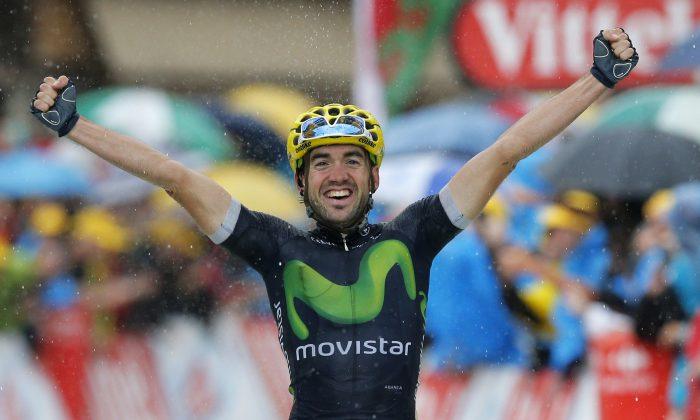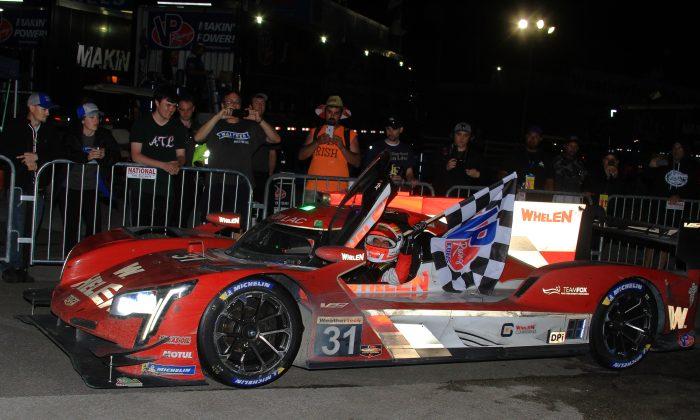Movistar’s Jon Izaguirre scored Spain’s first stage win in stage 20 of the 2016 Tour de France, by beating some the sport’s best descenders on a dangerously quick and slippery downhill.
Ixaguirre attacked on the final climb of the final mountain stage of this year’s tour, the Hors Categorie Col de Joux Plane, catching three riders: Etixx-Quickstep’s Julian Alaphillipe. Iam’s Jarlinson Pantano, and Astana’s Vincenzo Nibali—all noted descenders, proven by their performances on the treacherous wet descent down Montée de Bisanne in Stage 19.
Izaguirre gained 19 seconds over Pantano and 42 seconds over Nibali on the 12-kilometer downhill, getting a stage win for Spain and also one for his team, Movistar, which had come to the Tour hoping for an overall win.
“There were many quality riders in our breakaway group, so we’re very happy to finish ahead of them and win the stage,” Izaguirre told LeTour.com. “Beating Nibali in a downhill is something that counts in a career but Pantano also descents very well. I’m super happy. We came here with the SueñoAmarillo (yellow dream) but Froome was the strongest. At the end of the day, we’re happy with a spot on the podium [Quintana third], a stage win and the teams’ classification victory.”

Col des Aravis
A small group attacked early, morphed into a group of about a dozen, and attracted another couple chasers. These two groups merged within the first ten kilometers and formed the break of the day, 37 riders strong. This armada had a gap of 40 seconds when it hit the day’s first climb, the Cat 2 Col des Aravis.
This group contained Tinkoff’s Peter Sagan and Roman Kreuziger. Sagan, safely ensconced in the Sprinters’ green jersey, could have coasted all day, saving his legs for an effort on the Champs Elysée on Sunday. Instead, the World Champion did strong pulls at the head of the break to give his team mate Kreuziger a boost in the General Classification.
The rain hit the peloton before they hit the day’s second climb. After the spate of crashes in Stage 19, the rain certainly damped the descending speed of the riders.
Sagan kept the pace high on the climbs, however, squeezing riders out the back of the break as they ascended the Cat 1 Col de Colombière. The break was down to 25 riders by the time they hit the peak.

Colombière
A group of eight riders attacked the break between the descent from Colombière and the start of the next climb, the Cat 1 Col de la Ramaz: Sagan and Kreuziger led Jon Izagirre (Movistar,) Vincenzo Nibali (Astana,) Rui Costa (Lampre,), Jarlinson Pantano (Iam,) Julian Alaphilippe (Etixx,) and Alexis Gougeard (Ag2R.)
Sagan couldn’t hold the pace he had set—after 80 km of hard charging to help his team mate, the Slavic superman had to call it quits. Nibali tried to attack the break, as did Alexis Gougeard, but the Ag2R rider flatted and lost time. he fought his way back to the lead group and was seventh to the summit.
As Sagan dropped back, various riders from the chase group bridged across—most noticeably Lotto-Soudal’s Thomas De Gendt, intent on gaining every possible King of the Mountain point. De Gendt attacked the break three km from the summit and was first across, with Rui Costa and Pierre Roland on his wheel.
De Gendt had 31 seconds’ advantage over the top of the climb, and faced a long, slippery descent in hard rain. The rest of the break caught the Dutchman with 45 km left in the stage. Jarlinson Pantano attacked immediately followed by Julian Alaphillipe. This pair opened a minute’s gap in ten km, which they stretched to nearly two minutes by the start of the final climb of the day, the Hors Categorie Col de Joux Plane.
At this point Tinkoff’s Roman Kreuziger was virtually in second place; in response, Ag2R and Orica-BikeExchange took over the peloton, pushing the pace to protect the GC positions of their riders Romain Bardet and Adam Yates. Kreuziger moved to the front of the break and pushed hard, determined to preserve the 5:30 advantage over the peloton, and thus his podium finish.

Joux Plane
Julian Alaphilluipe and Jarlinson Pantano hit the Joux Plane with 90 seconds on the chasers, and four-and-a-half minutes on the peloton. When the peloton hit the climb. Astana’s Fabio Aru couldn’t hold the pace and dropped back. As soon as this news was relayed to Vincenzo Nibali, he attacked the break, followed after 30 seconds by Rui Costa.
The final five km of the climb averaged over nine percent, with ramps over 14 percent. When Alaphillipe hit this section, he attacked Pantano and opened a small gap. Pantano caught back up, and Alaphillipe attacked again.
This time when Pantano caught the Etixx rider, he went right over the top, showing that he was far from ready to quit. This pair rode together until Nibali caught them three km from the summit. Nibali attacked the pair three times before he finally got a gap.
While this was happening Movistar’s Jon Izaguirre attacked the break and bridged up to Pantano and Alaphillipe. The Movistar rider went right by and set off after Nibali. Pantano was able to respond and joined the chase, while Alaphillipe fell back slightly.
Pantano and Izaguirre caught the Astana rider about a kilometer from the crest of the climb. Pantano was first over the summit, but nearly went off on a wet corner. Nibali, normally an amazing descender, couldn’t keep up with the other two; possibly he was reliving his crash on a wet descent the day before.
Izaguirre got the stage win, the first for a Spanish rider in the 2016 Tour; Pantano finished second, which added with his two stage wins, made the 2016 Tour quite a success for the Iam rider—particularly important because Iam is shutting down its ProTour team after this season.
Nibali took third—not bad considering he was only riding the Tour to prepare for the Olympics. The podium finish also took some of the sting of Fabio Aru falling out of the top ten overall.

The Outcome
There were no changes among the top five in the General Classification. No one attacked, no one advanced. The gaps were too big and the riders too closely matched—and too wet, worn out, and beat up, after three weeks of racing, three days of mountains, and a second day of hard rain.
There was some movement in the top ten: Movistar’s Alejandro Valverde moved up to sixth, and Katusha’s Joachim Rodriguez gained four places to seventh. Tinkoff’s Roman Kreuziger gained two spots, from twelfth to tenth. he gained two-and-a-half minutes, but needed another two-and-a-half to pass Etixx-Quick-Step’s Daniel Martin—and that was beyond possibility, as Martin was riding well in Stage 20.
The biggest loser was Astana’s Fabio Aru, who dropped from sixth overall to thirteenth in this one stage. The race was one climb too long for the young Italian; her cracked at the base of the Col de Joux Plane and lost 13 minutes on the twelve-kilometer climb.

Three for Froome
The biggest winner was of course Sky’s Chris Froome, who effectively wrapped up his third Tour de France victory. Froome didn’t have a bad day throughout the 21 stages; even when he was hurt from crashing he managed to stay with the other GC contenders, and on every stage when he attacked, he gained time.
Unlike previous years, Froome didn’t devastate the field with an heroic performance on a mountain stage. Instead, he accrued an advantage in small chunks, on descents and flat stages as well as on hills. Only in the last time trial did he open a multi-minute gap on his rivals in one stage.
Froome unquestionably had the benefit of having the strongest team in the Tour—Wouter Poels in particular proved to be an invaluable assistant, always there and always willing to tow Froome forward no matter how steep the incline.
It was also Froome’s strategy which paid off. In past Tours he had exhausted himself by the final week, and only survived to win because he already had a sizeable lead. This year Froome came to the race intent on saving himself for the final week—taking time where he could, but not using his full strength early in the race.
That unused capacity came to his rescue after his crash on the descent of Montée de Bisanne. had Froome already been exhausted and fighting illness, he might have lost a lot of time in Stage 19, and might have lost his lead in Stage 20.
Equally, when Froome started the race in Stage 20 apparently in great shape, none of his rivals could then muster the motivation to attack. Had he showed weakness, Froome would have been a target. Instead, he showed nothing but strength surrounded by more strength.
“I’m pretty sore, all my knee and my back, but my legs were better today than yesterday after the crash,” the soon to be three-time Tour winner told LeTour.com. “I had that four minutes gap to play with. It gave me a breathing space. I just had to stay in front.
“It’s a huge relief to cross that finish line. The last 24 hours have been pretty chaotic but my team-mates helped me so much to keep the yellow jersey on my shoulders. It’s an amazing feeling [to win the Tour]. It could be like the first one again.”






Friends Read Free